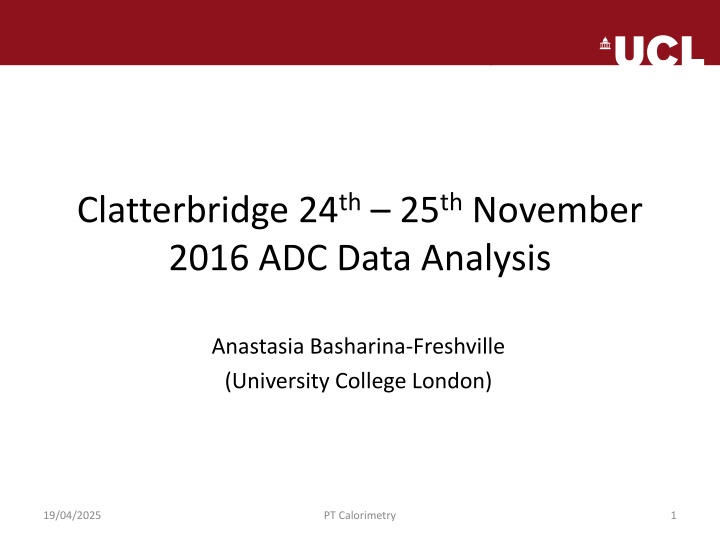
Clatterbridge ADC Data Analysis Summary
"Explore the detailed measurements and analysis conducted at Clatterbridge on 24th-25th November 2016, focusing on optical module setups, energy resolution, reproducibility, and more for PT Calorimetry."
Download Presentation

Please find below an Image/Link to download the presentation.
The content on the website is provided AS IS for your information and personal use only. It may not be sold, licensed, or shared on other websites without obtaining consent from the author. If you encounter any issues during the download, it is possible that the publisher has removed the file from their server.
You are allowed to download the files provided on this website for personal or commercial use, subject to the condition that they are used lawfully. All files are the property of their respective owners.
The content on the website is provided AS IS for your information and personal use only. It may not be sold, licensed, or shared on other websites without obtaining consent from the author.
E N D
Presentation Transcript
Clatterbridge 24th 25thNovember 2016 ADC Data Analysis Anastasia Basharina-Freshville (University College London) 19/04/2025 PT Calorimetry 1
Summary of Measurements Made Optical module setup used: 2 Hamamatsu R13089-100-11 PMT with negative HV UCL soldered base 3 cm x 3 cm x 5 cm cuboid ENVINET standard scintillator Coupled with BC-630 Saint Gobain silicone optical gel (refractive index = 1.465) http://www.crystals.saint-gobain.com/uploadedFiles/SG- Crystals/Documents/Organic%20Product%20Accessories%20Data%20Sheet.pdf Thursday the 24th August 2016: All measurements carried out at -900 V Measurements of beam operating at different rates (30 kHz 400 kHz) Monitoring of correlation between the rate measured on the oscilloscope and the displayed scattering foil current Waveform data collected with the LeCroy oscilloscope in order to more accurately measure rates Waveform data collected with the digitiser and the LeCroy oscilloscope simultaneously using a 50 LEMO splitter and barrels Peak current estimate at -900 V (for an amplitude of 447 mV and a width of ~16 ns, for a threshold of -100 mV): 11.2 mA 19/04/2025 PT Calorimetry 2
Summary of Measurements Made Wednesday the 3rd August 2016: All measurements carried out at -900 V Energy-range calibration scan with the Clatterbridge calibration wheel carried out at low rates starting at 50 kHz for a gate of 150 ns Measurements with two PMMA plate thicknesses corresponding to those of the wheel to establish whether we go through one or more of the wheel segments with the beam 19/04/2025 PT Calorimetry 3
Energy Resolution and Reproducibility of Measuremets: 60 MeV Beam 1.98 mm collimator Energy resolution: ~2.5 % Comparison of Runs at 60 MeV (No Absorber) Comparison of Runs at 60 MeV (No Absorber) adc adc adc adc adc adc adc adc 6329 6412 5965 Entries Mean RMS RMS RMS RMS Entries Mean Mean Mean Entries Entries 32768 6266 236.8 236.8 1020 950 32768 32768 32768 6266 6202 5772 Entries Mean RMS RMS RMS RMS Entries Mean Mean Mean Entries Entries 32768 6266 236.8 236.8 1020 950 32768 32768 32768 6266 6202 5772 12000 4 10 D Run 004, /E: 2.50 % D Run 004, /E: 2.50 % D Run 013, /E: 2.47 % D Run 013, /E: 2.47 % 10000 3 10 D Run 026, /E: 2.55 % D Run 026, /E: 2.55 % Number of events Number of events 8000 2 10 6000 4000 10 2000 1 0 5000 5500 6000 6500 7000 5000 5500 6000 6500 7000 ADC Counts ADC Counts Time difference between runs: 004: 12.27 013: 14.17 026: 15.38 19/04/2025 PT Calorimetry 4
Reproducibility of Measurements: Wheel Position 0 1.98 mm collimator Wheel position 0 (1.4 mm water equivalent, 1.2 mm PMMA) Energy resolution: 2.7 2.8 % Wheel Position 0 (0.6 mm PMMA/1.4 mm WE) and PMMA Comparison Wheel Position 0 (0.6 mm PMMA/1.4 mm WE) and PMMA Comparison Wheel Position 0 (0.6 mm PMMA/1.4 mm WE) and PMMA Comparison adc adc adc adc adc adc Entries Entries Mean RMS RMS RMS Entries Mean Mean 32768 5580 282.2 282.2 881.9 32768 32768 5580 5485 Entries Mean RMS RMS RMS Entries Mean Mean Entries 32768 5478 882.6 282.2 881.9 32768 5580 5485 32768 4 10000 10 s 0.2, m At start of testing, = 65.2 = 5672 s 0.2, m At start of testing, = 65.2 = 5672 s 0.2, m At end of testing, = 68.0 = 5680 s 0.2, m At end of testing, = 68.0 = 5680 8000 3 10 Number of events Number of events 6000 2 10 4000 10 2000 1 0 4000 4500 5000 5500 6000 4000 4500 5000 5500 6000 ADC Counts ADC Counts Time difference between runs: 001: 09.58 030: 11.27 19/04/2025 PT Calorimetry 5
Comparison of Wheel Position 40 and PMMA 1.98 mm collimator Wheel position 40 (7.2 mm PMMA), PMMA plate used: 7.24 mm Energy resolution: 2.5 3.5 % Wheel Position 40 (7.2 mm PMMA/8.4 mm WE) and PMMA (7.24 mm) Comparison Wheel Position 40 (7.2 mm PMMA/8.4 mm WE) and PMMA (7.24 mm) Comparison Wheel Position 40 (7.2 mm PMMA/8.4 mm WE) and PMMA (7.24 mm) Comparison adc adc adc adc adc adc adc adc Entries Mean Mean Mean Entries Mean RMS RMS RMS RMS Entries Entries 32768 4628 4454 4357 32768 32768 32768 4628 423.3 423.3 703.1 592.2 Entries Mean RMS RMS RMS RMS Entries Mean Mean Mean Entries Entries 32768 4608 743.2 423.3 703.1 592.2 32768 32768 32768 4628 4454 4357 4 9000 10 s m Wheel at position 40, = 77.9 0.2, = 4765 s m Wheel at position 40, = 77.9 0.2, = 4765 8000 s m PMMA in position of wheel, = 81.5 0.2, = 4609 s m PMMA in position of wheel, = 81.5 0.2, = 4609 s m PMMA upstream of beam, = 66.5 0.2, = 4495 s m PMMA upstream of beam, = 66.5 0.2, = 4495 7000 3 10 Number of events Number of events 6000 5000 2 10 4000 3000 10 2000 1000 1 0 2000 3000 4000 5000 2000 3000 4000 5000 ADC Counts ADC Counts 19/04/2025 PT Calorimetry 6
Comparison of Wheel Position 80 and PMMA 1.98 mm collimator Wheel position 80 (13.3 mm PMMA), PMMA plate used: 13.4 mm Energy resolution: 4.9 5.3 % Wheel Position 80 (13.3 mm PMMA/15.4 mm WE) and PMMA (13.4 mm) Comparison Wheel Position 80 (13.3 mm PMMA/15.4 mm WE) and PMMA (13.4 mm) Comparison Wheel Position 80 (13.3 mm PMMA/15.4 mm WE) and PMMA (13.4 mm) Comparison adc adc adc adc adc adc adc adc 9000 Entries Entries Entries Mean RMS RMS RMS RMS Entries Mean Mean Mean 32768 3594 3447 3441 32768 3594 342.8 342.8 524.6 404 32768 32768 Entries Mean Mean Mean Entries Entries Entries Mean RMS RMS RMS RMS 32768 3579 566.9 342.8 524.6 404 32768 3594 3447 3441 32768 32768 4 10 s m Wheel at position 80, = 79.9 0.2, = 3704 s m Wheel at position 80, = 79.9 0.2, = 3704 8000 s m PMMA in position of wheel, = 80.0 0.2, = 3570 s m PMMA in position of wheel, = 80.0 0.2, = 3570 s m PMMA upstream of beam, = 74.2 0.2, = 3539 s m PMMA upstream of beam, = 74.2 0.2, = 3539 7000 3 10 6000 Number of events Number of events 5000 2 10 4000 3000 10 2000 1000 1 0 2000 3000 4000 2000 3000 4000 ADC Counts ADC Counts is similar for measurements with the wheel and the PMMA plates We can conclude that we are therefore only going through one wheel segment. 19/04/2025 PT Calorimetry 7
Energy-Range Calibration Energy-Range Calibration at -900 V ADC Mean, ADC units 6000 Measurements at higher water equivalent depth do not produce a spectrum that can be fit with the Lan-Gaus convolution measured using a simple Gaussian around the peak for all points for consistency Note: The returned by Lan-Gaus and by the simple Gaussian fits are usually within 10 ADC counts of each other A more sensible looking calibration than August 2016 data? 5000 Bragg Peak Line 4000 3000 2000 1000 0 5 10 15 20 25 30 35 Water Equivalent Depth, mm 19/04/2025 PT Calorimetry 8
Energy-Range Calibration (Zoom Around Bragg Peak Points) Energy-Range Calibration at -900 V 3000 ADC Mean, ADC units 2500 Bragg Peak Line 2000 1500 1000 500 24 26 28 30 32 Water Equivalent Depth, mm 19/04/2025 PT Calorimetry 9
Energy-Range Calibration from Simulations Simulated Energy-Range Calibration at -900 V ADC Mean, ADC units 6000 5000 Bragg Peak Line One point has lower ADC than expected. Also seen in August 2016 data and simulations. Simulations carried out in GEANT v10.0.2 (SL 5) No beam line, scintillation turned off MeV to ADC calibration taken from MeV vs ADC plots on Slide 14 (data taken during this test beam) 4000 3000 2000 1000 0 0 5 10 15 20 25 30 Water Equivalent Path Length, mm 19/04/2025 PT Calorimetry 10
Energy-Range Calibration from Simulations (Zoom Around Bragg Peak Points) Simulated Energy-Range Calibration at -900 V ADC Mean, ADC units 2500 Bragg Peak Line 2000 1500 1000 500 24 25 26 27 28 29 30 31 32 Water Equivalent Path Length, mm 19/04/2025 PT Calorimetry 11
Energy Resolution as a Function of Energy (FWHM) Energy Resolution as a Function of Proton Energy: -900 V Proton Energy, MeV 50 55 25 30 35 40 45 60 Energy Resolution, % FWHM c c p0 p1 p2 2 2 / ndf p0 p1 p2 p3 p3 / ndf 1.898 / 10 13.96 2.227 - 109.6 0.09853 0.0006607 - 0.0006607 - 1.898 / 10 13.96 2.227 - 109.6 25 52 10.18 70.22 70.22 0.09853 52 10.18 y= p0+p1 x+p2 + p3 x x 20 NOTE: Systematic errors still need to be estimated for this data set Guesstimate for now just for the fit, with 1% for the lowest energy points A great 2/NDF even with incorrect errors 15 10 5 0 5 10 15 20 25 30 35 40 Visible Energy, MeV 19/04/2025 PT Calorimetry 12
Energy Resolution as a Function of Energy () Energy Resolution as a Function of Proton Energy: -900 V Proton Energy, MeV 50 55 25 30 35 40 45 60 s Energy Resolution, % 12 c c p0 p1 p2 2 2 / ndf p0 p1 p2 p3 p3 / ndf 1.898 / 10 27.56 5.94 0.9479 - 46.63 0.0002796 - 0.0002796 - 1.898 / 10 27.56 5.94 0.9479 - 46.63 y= p0+p1 x+p2 10 + p3 x 5.004 34.52 0.04817 0.04817 5.004 34.52 x 8 NOTE: Systematic errors still need to be estimated for this data set Guesstimate for now just for the fit, with 1% for the lowest energy points A great 2/NDF even with incorrect errors 6 4 2 0 5 10 15 20 25 30 35 40 Visible Energy, MeV 19/04/2025 PT Calorimetry 13
Linearity/Energy Scan: -900 V 1st degree polynomial fit over range shown on plot Linearity: 2 Inch PMT (UCL Base) + 3 cm x 3 cm Cube at -900V p0 gives an estimate of quenching in the scintillator (cf 20.49 MeV from simulations for EJ PVT scintillator): 18.06 Previously, the lowest proton beam energy we tested to was ~ 32 MeV Harder to fit the mean at lower energies due to lower statistics But even at lower energies we still look to be linear Proton Beam Energy, MeV 60 c c p0 2 2 / ndf p0 p1 p1 / ndf 3.663 / 6 0.1964 4.738e 4.738e 3.663 / 6 0.1964 18.06 18.06 55 - - 0.007197 0.007197 05 05 50 45 40 35 Previous PMMA plates used not below this line 30 25 0 1000 2000 3000 4000 5000 6000 7000 8000 ADC Mean, ADC units 19/04/2025 PT Calorimetry 14
Rate Tests 1.98 mm collimator ADC Spectra for Different Beam Rates ADC Spectra for Different Beam Rates adc adc adc adc 10000 Entries Mean RMS RMS Entries Mean 32768 5904 32768 5904 871 871 Entries Mean Entries Mean RMS RMS 32768 5904 871 871 32768 5904 4 10 D 30 kHz, /E: 2.54 % D 30 kHz, /E: 2.54 % D 50 kHz, /E: 2.50 % D 50 kHz, /E: 2.50 % 8000 D 100 kHz, /E: 2.78 % D 100 kHz, /E: 2.78 % 3 10 D 220 kHz, /E: 1.85% D 220 kHz, /E: 1.85% Number of events Number of events 6000 2 10 4000 10 2000 1 0 0 5000 10000 15000 0 5000 10000 15000 ADC Counts ADC Counts As rate increases, ADC mean increases and energy resolution appears to improve. The ADC mean increasing is the opposite trend to the data we collected in August 2016 with the Hamamatsu active divider base! 19/04/2025 PT Calorimetry 15
Scope Rate Scattering Foil Current Calibration Calibration of Scope Rate vs Scattering Foil Current The plot currently shows scope rate measured at Clatterbridge using the duration function For complete accuracy we need to analyse scope waveform data to get accurate rates Once we have an accurate measurement of this calibration we should be able to rely on the scattering foil current for rate measurements Rate measured on scope, kHz c c p0 p1 2 2 / ndf p0 p1 p2 p2 / ndf 3289 / 3 21.69 0.3145 0.0006261 0.0006261 3289 / 3 21.69 0.3145 400 39.73 1.34 39.73 1.34 350 - - 0.001271 0.001271 300 250 200 150 100 50 0 0 100 200 300 400 500 Scattering Foil Current, pA 19/04/2025 PT Calorimetry 16
Radiation Damage Assessment 207Bi tests carried out at -1700 V: before test beam: 21/11/2016 after test beam: to be done Total radiation dose received by 2 OM (not yet accounting for collimators etc.): 428.4 monitor units (0.9 Gy/monitor unit) in 367 minutes of running. Scaling for 1.98 mm collimator diameter from a 17 mm beam diameter and converting to Gy: 1.5 Gy This scintillator has now received a total of 4.2 Gy (August 2016) + 1.5 Gy (November 2016): 5.7 Gy bi207_3890 Entries 667907 207 207 Bi Runs Before and After Nov 2016 Test Beam Bi Runs Before and After Nov 2016 Test Beam 350 Numer of Events Mean RMS 425.2 139 UCL DAQ, UCL HV, 21.11.16 300 UCL DAQ, UCL HV, 16.01.17 250 Date HV DAQ E/E (%) 200 Supply 21/11/1 6 UCL UCL 9.02 0.22 150 100 Clatterbridge Test Beam: 24-25/11/16 50 16/01/1 6 UCL UCL 7.98 0.15 0 200 300 400 500 600 700 ADC Counts No noticeable worsening in resulting energy resolution. 19/04/2025 PT Calorimetry 17






















